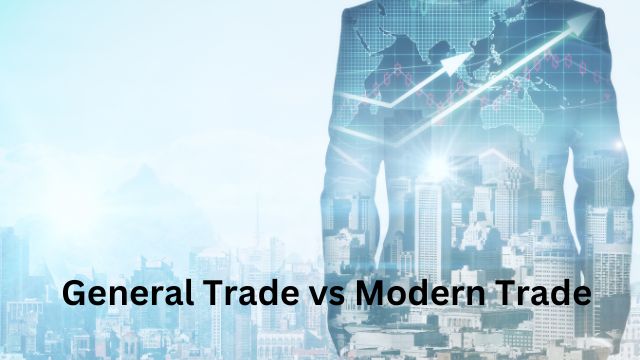Now, many of you may already be familiar with the concept of trade, right? But did you even know that there are mainly two types of trades which happen all the time around us? Yeah, that’s a 100% true, and today we are gonna look at those two types. We are talking about general trade and modern trade, and if you don’t know what the key differences between these two are then keep on reading because that’s what we are onto today. We’ll talk about what trade actually means, what is general trade, and what is modern trade, and we will also disclose all the key differences between these two. So yeah, let’s get to it without further ado, shall we?
Different Types Of Trades
Ever wondered what’s the real deal with the different types of trades out there? Let’s dive right in, shall we? Trade, it’s the heartbeat of the global economy, keeping those commerce wheels spinning round and round. And yeah, over time, trade’s gone through a massive transformation, splitting into two main kinds: General Trade and Modern Trade. Now, here’s the thing though: even though both these types are about exchanging goods and services, they’re kind of like distant cousins rather than twins. They’ve got their own ways of doing things, operate on different scales, and boy, do they have diverse impacts! So yeah, it is more than just buying and selling, it’s about how we do it and the ripples it creates.
1. General Trade
Ever heard of General Trade? It’s pretty much what you call traditional trade, and guess what? It’s all about those local vibes. We’re talking small retailers, the friendly dealers down the street, those wholesalers who know exactly what you need, and distributors who feel like part of the neighborhood. It’s huge in places where a handshake and a smile from your shopkeeper mean more than just a transaction. It’s where buying and selling go beyond business. It’s about building connections. That’s General Trade for you, deeply rooted in local communities where everyone knows your name!
- Local Vibes, Less Fancy Tech: Ever noticed how in smaller towns or the not-so-urban parts of the city, it’s all about those quaint, family-owned shops? That’s General Trade for you, folks. It’s less about high-tech setups and more about those friendly nods and handshakes. We’re talking about a world where market presence is king, but it’s all cozy and regional.
- Reaching Customers the Good Old-Fashioned Way: Now, let’s talk about how General Trade hooks its customers. Imagine walking into a store where the owner knows your name, maybe even your dog’s name! That’s the charm. Sales in General Trade? It’s all about direct, personal connections. These local traders know their customers like the back of their hand, creating a bond that’s all about trust and familiarity.
- Negotiate Your Way Through: Ah, the pricing game in General Trade. Here’s where you can flex your bargaining skills. Ever haggled over a price and walked away feeling like a winner? That’s the drill here. Prices aren’t set in stone; they dance to the tune of local vibes and good ol’ negotiation. It’s not just buying and selling, it’s an art form, a dance of sorts, where personal chit-chat can swing a deal.
- Rooting for the Local Economy: Here’s the heartwarming part though, you see, General Trade is like the backbone of local economies. It keeps the traditional crafts alive, supports small-scale industries, and yeah, it is kinda like a lifeline for many in these communities. It’s not just a trade; it’s about preserving a way of life, about keeping the culture going strong and alive.
2. Modern Trade
Have you ever walked through a bustling city and noticed those huge supermarkets or hypermarkets? Or maybe you’ve clicked your way through countless products on an e-commerce platform. That is Modern Trade in action, and it’s totally reshaping the way we shop. Think about it: it’s everywhere in urban and metropolitan jungles. Modern Trade is all about those organized, shiny retail formats that make shopping a breeze. Now, this isn’t your grandma’s General Trade. Nope, it’s a whole different ball game. We’re talking big league here – national or international chains that are part of our everyday lives. They’ve got everything: a zillion products, from groceries to gadgets, all under one roof. It’s like they took shopping, added a dash of high-tech, and turned it into this super-efficient, streamlined experience. And yeah, the evolution of Modern Trade has been a game-changer for the retail world. Remember the good old days of asking shopkeepers for every little thing? Well, Modern Trade said, ‘Nope, let’s switch things up.’ Now, it’s all about self-service. You pick, you choose, you decide. That’s how it is now.
- Advantages for Brands: So, why are brands focusing more and more on Modern Trade these days? Well, it is kinda like hitting the jackpot for them, so of course, they’re gonna adapt to it, right First things first, they’re scaling up massively, we’re talking sky-high growth and soaring revenues here. And who wouldn’t get excited about that? On top of that, these brands’ products are also getting the spotlight in these flashy or big retail spaces, which is exactly what they aim for. Now, that’s a double win. But yeah, it’s not just about size, these platforms add a dash of style with some top-of-the-line visual merchandising too.
- Challenges and Limitations: Now, let’s talk about the not-so-great side of modern trade. It is pretty easy for us customers to think that it is all rainbows and butterflies with the modern trade thing, but there sure are some challenges that brands have to face. But what could these challenges or limitations be, you ask? First things first, this whole modern trade stuff is mostly happening in the city areas. So, what about the rural folks? Well, they’re kinda getting the short end of the stick here, being left out and all. And that’s not it though, if you’re a business or brand owner stepping into the modern trade arena, brace yourself. You’re gonna bump into a whole bunch of rules and regulations that you probably never dealt with in the old-school way of doing things.
- Impact on Consumer Behavior and Market Dynamics: Since modern trade became the big thing it is now, it’s been turning consumer behavior and market dynamics upside down. You see, competitive prices are everywhere, which sounds like a win for us as shoppers. But, you see, brands and businesses gotta hustle hard, competing at a whole new level just to acquire a customer or make a sale. And yeah, this whole scenario could end up making just a couple of brands the big shots, dominating the market. You might be wondering, ‘What’s the big deal with that?’ See, if this keeps up, we’re looking at a potential monopoly situation. And trust me, that’s not the kind of game we, as customers, want to play in the long run.
Key Differences Between General Trade And Modern Trade

Alright, enough with the introduction of general trade and modern trade, now’s the time to actually see where these two stand practically in today’s market. Here are some of the key differences between modern trade and general trade:
1. Reaching Every Corner
You know, it’s like Modern Trade mainly focuses on the urban and suburban crowds, while General Trade isn’t afraid to go deep into those remote and less-served areas. Put these two together, and what do you get? A perfect recipe for brands to spread their wings across a diverse audience, making sure they cover the whole market.
2. Choices and Deals
Here’s the deal with General Trade, the variety might not be huge, and the prices? They’re usually what you see is what you get. But, flip the coin to Modern Trade, and it’s a whole different game. You’ve got a rainbow of product choices and hey, who doesn’t love a good discount?
3. Building Bonds vs. Quick Buys
When we talk about General Trade, it’s all about that personal touch with customers, really building a bond. On the flip side, Modern Trade is the king of efficiency. It’s more about getting in, grabbing what you need, and getting out. This difference? It’s huge when it comes to how people shop and connect with these platforms.
4. Balancing the Scales
Like, you might have heard a million times that putting all your eggs in one basket is never a good idea. Right? And that is possibly the case with brands or businesses because If they lean too hard on just General or Modern Trade, then that would be like walking on thin ice. Mixing it up, balancing the two, now that’s the smart play. It’s all about hitting that sweet spot for better profits and staying steady when the market throws a hard time your way.
Conclusion
That’ll do it for now. We hope that after reading today’s post, you are feeling a lot clearer in your head about general trade and modern trade. Right? Well, if there still are some thoughts that are making you wonder a lot about these two, then we’d advise you to dig a little deeper and find out more through many sources available online. That would help you clear things, and you’ll practically become a pro at identifying what’s what and where general trade or modern trades are happening.
Anantha Nageswaran is the chief editor and writer at TheBusinessBlaze.com. He specialises in business, finance, insurance, loan investment topics. With a strong background in business-finance and a passion for demystifying complex concepts, Anantha brings a unique perspective to his writing.


